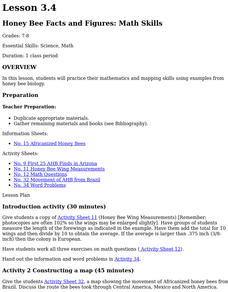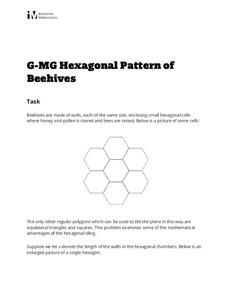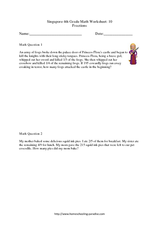Curated OER
The Disappearing Honeybees: Tracking Honeybee Decline
Students practice graphing and other math skills to track number of honeybee colonies present in United States since 1978, discuss major crops that are dependent on insect pollinators, and examine reasons for decline of United States...
Curated OER
Honey Bee Facts And Figures: Math Skills
Young scholars practice their mathematics and mapping skills using examples from honey bee biology. Discuss why the colonies were found in this pattern. They examine food and water in the area, and how many humans live in the area where...
K5 Learning
The Bee
See what all the buzz is about with a reading comprehension activity! Third and fourth graders read a short informational passage about bees before answering four questions about what they have learned.
Curriculum Corner
Bugs and Flowers Math and Literacy Centers
The sun shines, flowers bloom, and bugs fly—it must be Spring! Add a cheerful theme of bugs and flowers to math and literacy centers. Scholars take part in an assortment of activities designed to reinforce concepts such as...
K5 Learning
The Bee
Early readers follow along as Lucy and her mother discuss why a bee is stuck in a flower then answer four reading comprehension questions.
National Park Service
Biodiversity—Bee Week
If you want scholars to fall in love with bees, this is the unit for you! Celebrate bees with a full week of material—designed for the Next Generation Science Standards—that addresses the importance of pollination and fertilization....
Curated OER
A Honey of a Hexagon
Learners explore how bees make honey and why the hexagon is the best basic pattern for the honeycomb through the use of a video and hands-on activities with honeycombs and geometric shapes.
Illustrative Mathematics
Hexagonal Pattern of Beehives
Young geometers and biologists investigate the math of nature in an activity that is just the bee's knees. Participants will study the tessellations of hexagons in a beehive, along with the natural rationale behind the specific shape....
Curated OER
All A-buzz About Math
Second graders participate in Math-Eze activities to comprehend word problems. For this word problem lesson, 2nd graders recognize why a hexagon is the best shape for a beehive. Students calculate how far bees must travel to find 2 lbs....
Curated OER
Too Bee Or Not To Bee
Students recognize that bees are important in the reproduction of plants and to the survival of animals. In this bee lesson, students become familiar with the parts of bees and how those adaptations help them pollinate plants....
Curated OER
How Busy Are Bees?
Young scholars research the jobs of bees. In this timeline lesson, students map out each of the six different jobs a worker bee does in its lifetime. They create a timeline and then retell the job descriptions.
Curated OER
The Buzz on Bees-How Bees Make Our World a Little Sweeter
These lessons can help students learn about the important role bees play in the ecosystem.
Curated OER
Honey ! I Blew Up The Bee!
Second graders complete a variety of bee-themed activities. They consider the importance of honeybees in food production, conduct Internet research, prepare foods using honey, complete puzzles and compile a portfolio of their work.
EngageNY
Posing Statistical Questions
Is this a statistical question? The opening lesson in a series of 22 introduces the concept of statistical questions. Class members discuss different questions and determine whether they are statistical or not, then they sort the data...
Curated OER
Writing Subtraction Sentences
In this math worksheet, students solve 35 simple subtraction word problems. Students read the problems and build the subtraction sentence and solve. There 5 pages with 7 problems on each.
Curated OER
The Honeycomb Challenge: Shapes and Colors
Play this game with young English language learners to help them learn color and shape vocabulary. As they make their way around the game board, they talk about the colors and shapes they pass and land on. Add math skills practice by...
Curated OER
Math Word Problems
In this word problems worksheet, students solve and complete 7 different word problems. First, they determine how long it takes a worker bee to complete a trip from her colony to a pollen and nectar source. Then, students find the number...
Curated OER
Singapore 4th Grade Math Worksheet: 10: Fractions
In this problem solving worksheet, students read and solve 20 word problems. The problems will require reading a short paragraph each, but use basic operations to solve. All problems contain fractions.
Curated OER
Money: Pennies
In this counting pennies worksheet, students count and add pennies, and record the total money amount. Students solve 6 problems.
Curated OER
Kites
Learners practice estimating and comparing measurements using yards, feet, and inches. They make comparisons about kites and a variety of measurements. Afterwards, they complete an activity sheet and draw a bird kite with long wings and...
Curated OER
Catch As Catch Can
Students capture and observe insects. Using provided netting, students design and create a butterfly net. They study many types of insects and their benefits. After identifying insects caught, students complete a graph. Students write...
Curated OER
Catch as Catch Can
Students investigate insects. In this insect analysis lesson, students catch insects using nets they make. They identify the insects they catch and create a chart to show the numbers and varieties. This lesson includes a vocabulary list...
Scholastic
Scholastic Instructor: Explore the World of Honeybees
Discover more about bees through this educational resource. This resource features math and science activities, experiments, fun facts, and more.
Illustrative Mathematics
Illustrative Mathematics: G Mg Hexagonal Pattern of Beehives
Beehives are made of walls, each of the same size, enclosing small hexagonal cells where honey and pollen are stored and bees are raised. This problem examines some of the mathematical advantages of the hexagonal tiling in a beehive....

























